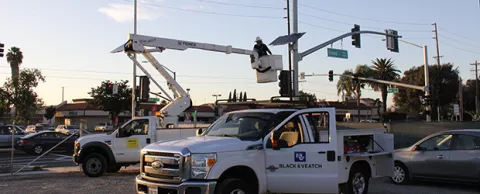
By Erica Zamensky, Black & Veatch
From parks to parking lots, street lights are everywhere. Los Angeles has 220,000 street lights, for example and San José has over 60,000.
Street lights consume a lot of power, typically accounting for 40% of a city’s electric bill. To shrink lighting costs, cities are scrambling to swap traditional high- and low-pressure sodium lamps for light emitting diodes (LEDs).
To increase the bang for their buck, cities are adding control systems at a low incremental cost to net an impressive 60-85% energy savings, halve their annual maintenance costs and significantly decrease carbon loading.
Spurred by the Internet of Things (IOT), cities are leveraging the LED retrofit process to jumpstart smart city progress. Black & Veatch is helping cities add wired and wireless network communications and sensors to street lights to create a multi-tasking technology platform that supports smart applications. These smart street lights accelerate greenhouse gas (GHG) reduction and provide the same energy and maintenance savings as LEDs, while enhancing the city experience and driving future connectivity.
As a mayor’s trump card, smart street lights help create livable cities that are distinct, hospitable and designed for interaction. These floodlit urban hubs help keep citizens safe, in-the-know and on-the-go. Safety services such as strike proximity alerts, push-to-talk call stations and amplified lighting during emergencies create a strong sense of safety within the city. Leading-edge services like Wi-Fi hotspots, real-time city information, music speakers and electric vehicle and bike charging bases cultivate city appeal, which can invigorate urban spaces and bolster economic development.
These transformative luminaires spotlight smart city progress. Dispersed throughout the city, street lights are ideal data command posts that gather and convey city data, such as air quality, traffic and noise levels.
Over time, a city can add applications onto the streetlight communications platform, which allows separate systems to “talk” to one another — the essence of Smart Cities. Integrated city operations increase efficiency and enable a coordinated, rapid response to real-time events.
For example, cities can connect their streetlight and transportation systems. When the traffic sensor on the streetlight indicates congestion, city staff can adjust the timing of signals to alter the flow of traffic. As connections multiply, Black & Veatch ensures that cities gain full benefit by weaving the hardware and software building blocks of street lights and other Smart City applications into one unified system.
Today’s cities face increased urbanization, mounting demand for sustainable energy and pressure to build livable urban spaces. Amid the clamor and commotion of urban planning, smart street lights are a beacon of opportunity.
With a focus in science, engineering, and smart city technologies, Erica Zamensky’s body of work includes research/writing technical manuals and reports, white papers, congressional review technical summaries, issue papers, and marketing materials. Erica’s technical and creative writing portfolio includes over 30 articles published in magazines and professional journals. Erica is a Senior Technical Writer in Black & Veatch’s Smart Integrated Infrastructure business.



